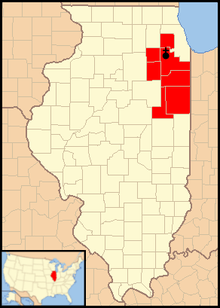Roman Catholic Diocese of Joliet in Illinois
The Roman Catholic Diocese of Joliet in Illinois (Latin: Dioecesis Joliettensis in Illinois) is an ecclesiastical territory or diocese of the Roman Catholic Church in the United States. It comprises the City of Joliet in Illinois and its surrounding counties: DuPage, Ford, Grundy, Iroquois, Kankakee, Kendall and Will.[1] It is governed by a bishop, who is a suffragan of the Archbishop of Chicago. The mother church is the Cathedral of St. Raymond Nonnatus.
Diocese of Joliet in Illinois Dioecesis Joliettensis in Illinois | |
|---|---|
Cathedral of St. Raymond Nonnatus | |
 | |
| Location | |
| Country | |
| Ecclesiastical province | Chicago |
| Metropolitan | Chicago |
| Statistics | |
| Area | 4,218 sq mi (10,920 km2) |
| Population - Total - Catholics | (as of 2010) 1,904,000 655,051 (34.4%) |
| Parishes | 120 |
| Information | |
| Denomination | Catholic |
| Sui iuris church | Latin Church |
| Rite | Roman Rite |
| Established | December 11, 1948 (71 years ago) |
| Cathedral | Cathedral of St. Raymond Nonnatus |
| Patron saint | St. Francis Xavier |
| Current leadership | |
| Pope | Francis |
| Bishop elect | Ronald A. Hicks |
| Apostolic Administrator | Richard Pates |
| Bishops emeritus | R. Daniel Conlon |
| Map | |
 | |
| Website | |
| dioceseofjoliet.org | |
On May 17, 2011, the Apostolic Nuncio to the United States, Archbishop Pietro Sambi, announced that Pope Benedict XVI named Bishop R. Daniel Conlon, 62, until then Bishop of the Roman Catholic Diocese of Steubenville in Steubenville, Ohio (part of the Ecclesiastical Province of Cincinnati, Ohio), as Bishop of the Roman Catholic Diocese of Joliet (part of the Ecclesiastical Province of Chicago, Illinois), succeeding Archbishop James Peter Sartain, who became archbishop of Seattle, Washington in September 2010.
History
In 1808, the area that is now known as Joliet was governed by the Diocese of Bardstown, present-day Archdiocese of Louisville in Kentucky. In 1824, administration of the area was transferred to the Archdiocese of Saint Louis in Missouri. Another period of reorganization for the expanding American Catholic community led to the transfer of administration over Joliet to the now-defunct Diocese of Vincennes, present-day Archdiocese of Indianapolis. In 1836, with the construction of the I&M canal, Irish immigrants swarmed into the area. Fr. John Plunkett was assigned to provide to the spiritual needs of the workers. He established St. Patrick Church, which is still operating, as the first church in the Joliet area.
With the industrialization of Illinois and the emergence of Chicago as an important center of commerce for the nation, the new churches and missions in the Joliet area flourished. Its congregants were mostly newly arrived immigrant laborers from Europe and several generations of local farmers.
In 1948, Pope Pius XII established the Diocese of Joliet to meet the demands of the exponential growth of Catholicism in the region, resulting from local post-World War II housing developments and commercial modernization, and named Reverend Martin McNamara as the first bishop. Bishop McNamara selected St. Raymond's church as the cathedral, however by 1950, the 540-seat church proved inadequate and he began planning a new facility. The Bishop consecrated the new Cathedral of St. Raymond Nonnatus on May 26, 1955.[2]
Reports of sex abuse
In April 2015, the Diocese of Joliet agreed to pay $4,137,500 to resolve the claims of 14 males who were the victims of abuse by priests of the diocese from the 1960s through the 1980s.[3] A list released by the Diocese of Joliet in August 2018 revealed the names of 35 clergy who served in the diocese during a 70-year period and were "credibly accused" of sex abuse.[4] On August 31, 2018, it was announced that the diocese had agreed to pay $1.3 million to three males who claimed they had been sexually abused in the diocese during the early 1980s.[5]
Bishops
Bishops of Joliet in Illinois
- Martin Dewey McNamara (1948–1966)
- Romeo Roy Blanchette (1966–1979)
- Joseph Leopold Imesch (1979–2006)
- J. Peter Sartain (2006–2010), appointed Archbishop of Seattle
- R. Daniel Conlon (2011–2020)
Auxiliary Bishops
- Romeo Roy Blanchette (1965–1966), appointed Bishop here
- Raymond James Vonesh (1968-1991)
- Daniel Kucera, OSB (1977-1980), appointed Bishop of Salina and later Archbishop of Dubuque
- Daniel L. Ryan (1981-1984), appointed Bishop of Springfield in Illinois
- Roger Kaffer (1985-2002)
- James Edward Fitzgerald (2002-2003)
- Joseph M. Siegel (2009-2017), appointed Bishop of Evansville [6]
High schools
- Benet Academy, Lisle
- Bishop McNamara High School, Kankakee
- Chesterton Academy of the Holy Family, Lisle [7]
- IC Catholic Prep, Elmhurst
- Joliet Catholic Academy, Joliet
- Montini Catholic High School, Lombard
- Providence Catholic High School, New Lenox
- St. Francis High School, Wheaton
References
- "About Us: Statistics". Diocese of Joliet. Retrieved 2016-03-04.
- "History of the Diocese of Joliet, Illinois". Diocese of Joliet. Retrieved 2016-03-04.
- https://illinoissexabuseattorney.com/roman-catholic-diocese-joliet-settles-claims-14-individuals-abused-priests/
- https://patch.com/illinois/joliet/35-joliet-priests-had-credible-child-sex-abuse-allegations
- http://www.chicagotribune.com/suburbs/ct-met-joliet-priest-sex-abuse-settlement-20180830-story.html
- Harris, Elise (18 October 2017). "Pope taps Joliet auxiliary to head Evansville diocese". Catholic News Agency. Retrieved 18 October 2017.
- https://chestertonacademyoftheholyfamily.com/
External links
| Wikimedia Commons has media related to Roman Catholic Diocese of Joliet in Illinois. |